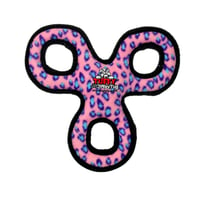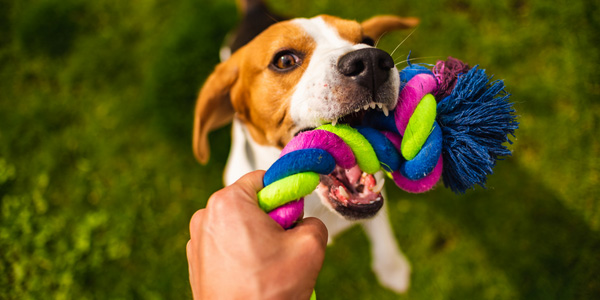
You might have heard that playing tug of war with your dog, especially a puppy, puts them on the path toward aggression. If you’ve heard this, you’ve heard wrong.
Playing tug of war with a dog will not cause your dog to become aggressive. But how you play tug of war can exacerbate or lead to aggressive behaviors. Yet it is remarkably easy to avoid this.
It is good to play tug of war with your dog, whether they are a puppy or an adult. Tug is a way for your dog to practice instinctual behavior — tugging at a toy mimics what a predator does when they finish the hunt, pulling apart the carcass or "dissecting" before eating. Dogs need to practice their natural behaviors, and doing so helps prevent undesired behaviors like destructive chewing.
More benefits of playing tug with your dog include:
- Tug of war is an excellent way to bond with your dog
- Tug of war gives your dog an outlet for energy and an opportunity for physical exercise, even when you can’t go outdoors
- Tug of war teaches dogs about rules and boundaries, especially during the puppy nipping and teething phase
- Tug of war is an excellent game to help teach your dog the drop it cue
Table of Contents
Does Playing Tug Make a Dog Aggressive?
Tug of war played the right way and under the right circumstances, will not encourage aggression in your dog. Instead, it will actually give you a tool to establish a healthy relationship with your dog.
There’s even some science behind it. A 2003 study published in the Journal of Applied Animal Welfare Science examined 50 people and their dogs playing tug of war and other roughhousing-type games. According to the researchers, the game itself had no significant impact on aggression in the dogs. In fact, they reported that dogs that played tug of war and fetch had more confident interactions with their people.
Aggression was found to be a potential issue depending on who started the game. If the dog always started the game, they tended to be more aggressive and less responsive to their people. When people started the game and set the rules, it helped promote positive behaviors in the dog.
This is important: You should NOT play tug of war with a dog that is already aggressive, exhibits resource guarding (aggressively protects their food, toys, etc.), or is showing early signs of either. Tug of war won’t make your dog aggressive, but it might intensify unwanted behaviors or patterns that are already present.
Before you play tug of war, you need to set a few ground rules.
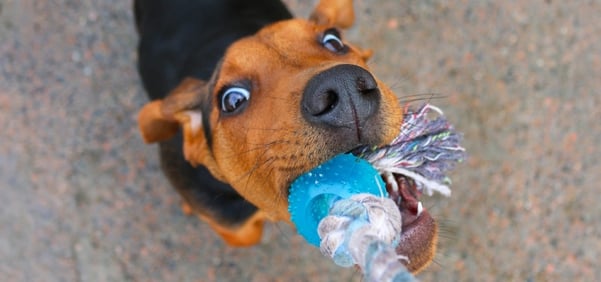
How to Play Tug of War With Your Dog
Rule 1: Safety First!
When playing tug with your dog, you want to make sure you only play tug side to side. Avoid pulling the toy up and down or dragging your dog around by the toy. And never pull the toy up high enough that your dog is hanging from the toy above the ground. Doing so can injure their neck and spine.
Match your tug intensity to their size and body. Keep your tug motions as smooth as possible. Don't jerk or yank too hard on the toy. If you have a small dog, you may not feel like you're tugging much at all, especially compared to playing tug with a larger, bulkier breed. But it's not about how intense the tug game is, it's more about the partnership between you and your dog.
Avoid playing tug if your dog has neck issues, IVDD (intervertebral disc disease), or arthritis.
Rule 2: No Teeth on Skin
If your dog’s teeth touch any part of you — hand, arm, leg, even your clothing — the game is temporarily over. When this happens (it will be an accident at first, but can become dangerous if you don’t stop the unwanted behavior early and often), stop the game immediately. Let them calm down before resuming the game. If their mouth touches you more than two or three times in a row, the game is over for the day.
Speaking of teeth, if you are playing tug with a puppy, evaluate their teeth before playing tug to be sure that none are loose or hanging, especially the canine teeth. Tug may cause pain by pulling uncomfortably on or pulling out these teeth before they are ready to fall out on their own. That pain could cause an aversion to the game of tug for young pups, as we want this game to be all about having a great time.
Rule 3: Practice Lots of Drop It
Teach your dog how to “drop it” as soon as possible. During your tug games, ask your dog to “drop it” and wait for them to let go of the toy. When you do this, make sure to stop pulling on the toy so they don't still get to play and ignore your cue. Only resume the game once they let go and wait for you to say it’s OK to play again. Listening and letting go of the toy = more play with you!
See me play tug with puppy Finnegan and introduce the drop it cue in this video:
If your dog has a hard time with drop it during games of tug, play with two toys. Ask your dog to drop the toy they have in their mouth and reward with the second toy. You can also bring in food treats as a reward for dropping an item, however, in my experience, once a dog realizes you have food treats, they could care less about playing tug!
Rule 4: Let Your Dog Win Sometimes
No one wants to play a game they never win. When playing tug with your dog, let them "win" the game by letting go of the toy after a particularly good tug. Praise them and make a big deal about how they won! This helps prevent frustration for your dog and is a great way to build your relationship. It's also a great way to gauge whether they are having fun or not. Do they come back towards you with the toy and want to play some more? That's a great sign that they love to play with you.
Rule 5: You Decide When to Play and When to Stop
You don't want your dog to get in the habit of pestering you to play tug with them. Don't always give in to their "requests" to play tug. If they approach you with a tug toy but you're busy doing something else, simply say "no thanks!" and go back to what you were doing. If they persist, then simply put the tug toy away and give them something else to do on their own. Our dog enrichment article has lots of ideas for ways a dog can entertain themselves and burn excess energy.
After a good game of tug when you're ready to pack it in, you can either ask for a final "drop it" or say "all done!" and end the game. It can help to give your dog a calming activity after a game of tug, such as a chew or licking mat, which helps them decompress and settle down.
Best Tug-of-War Toys for Dogs
Rope Toys
For tug of war, you can’t do much better than a good, old-fashioned rope toy. Ropes are soft enough that your dog can get a good hold without cracking their teeth but durable enough to withstand lots of games of tug of war. Look for a rope toy that's malleable enough to easily bend in your hands and hold — you don't want a too thick or stiff rope for tug games.
However, do not leave ropes with your dog unattended, and stop using a rope toy if your dog begins to pull off threads during your tug-of-war games. Plenty of dogs have undergone surgery to remove strands of rope from their stomach or intestines, and linear foreign bodies are dangerous! Rope toys can also harbor dirt and bacteria, and since they are hard to clean, it’s usually easier to just replace them when they get too dirty.
Rubber Tug Toys
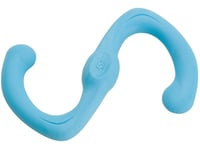 Other tug toys such as rubber “handle” toys are also soft enough to protect your dog’s teeth but durable enough to withstand some good tugs. However, these toys can be hard for some dogs to hold firmly in their teeth. And make sure your dog isn’t able to rip off pieces of the toy and swallow them, as it can easily cause a digestive obstruction. For non-rope toys, I highly recommend the Westpaw Bumi.
Other tug toys such as rubber “handle” toys are also soft enough to protect your dog’s teeth but durable enough to withstand some good tugs. However, these toys can be hard for some dogs to hold firmly in their teeth. And make sure your dog isn’t able to rip off pieces of the toy and swallow them, as it can easily cause a digestive obstruction. For non-rope toys, I highly recommend the Westpaw Bumi.
The Bumi has been a favorite tug toy for both playing with us humans, as well as for tug games between my two dogs together (seen in the photo below). It's nice and flexible, soft enough for my senior dog's sensitive teeth but durable enough for my younger dog's strength. Plus, I can just toss it in the dishwasher for regular cleaning.
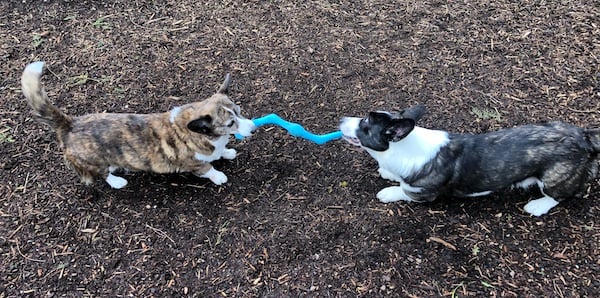
Make sure that any toy you give your dog is soft enough that it will “give” a bit if you press it with your thumbnail but durable enough that your dog won’t rip off and swallow pieces of it. Learn more about how to pick the best option for your dog by reading “3 Simple Steps to Choose the Best Chews for Your Dog.”
Soft Tug Toys
For smaller or less-intense tug-of-war dogs, a stuffed toy, like this soft Tuffy tug toy, can be great for a game, as long as your dog doesn’t tear apart the toy and try to eat the stuffing inside. However, the Tuffy brand stands up to a lot of chewing and pulling.
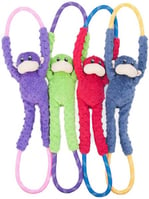 Long-Handled Tug Toys
Long-Handled Tug Toys
If your puppy is working through their nipping and teething phase, I highly recommend getting a long tug toy so that there is a lot of space between their mouth and your hands. I've used the ZippyPaws Monkey Ropetugz toy quite a bit, and I love that it has two handles with the soft stuffed toy in between.
If your dog is particularly toothy in their tug play, you may want to consider not playing tug at all. Instead, use a flirt pole that they can chase, catch, and shake. Or see if they enjoy a game of fetch instead. Both of these games also help practice the drop it cue and encourage cooperation in play between you and your pup.


